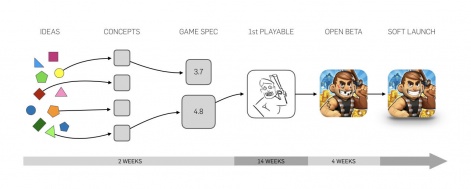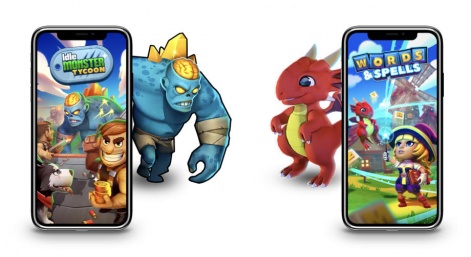This is a guest column from Teppo Soininen, the CEO of Finnish developer Ministry of Games.
We founded Ministry of Games five years ago and after spending all that time working on two games - Spell Brawl and Trade Town - that ended up failures, we decided to develop a radical new way of working.
Our main idea was to create a process for rapidly verifying early gameplay. We call this the new approach the Rapid Development Funnel or RDF.
The goal of the RDF is to push games from idea to open beta in four months.
Our rapid development funnel is divided into 5 major stages:
- Ideas
- Concepts
- Game specification
- First playable
- Open beta
IDEAS
At the first stage of RDF we invite everyone to come up with ideas for games. Idea presentations outline the game with enough detail so that people can understand what the game is about.
We try to avoid criticism and keep an open mind, skip questions about market realities, the team’s capability to deliver etc.
Idea presentation are typically a handful of slides showing inspirational images, rough game loops and other information that help others imagine the game.
During the presentation the team digs into details by asking questions. At this stage questions should focus on the game, how it would play, how it would look etc.
We try to avoid criticism and keep an open mind, skip questions about market realities, the team’s capability to deliver, project scope etc. It's okay not to have all the answers at this point. The most important thing is to discuss the idea and look at it from many angles.
CONCEPTS
The second stage of RDF is concepting. Teams of 1-4 people pick up an idea they’re excited about. The goal here is to answer all the questions and cover all unknowns as best as possible.
As a result we will have a detailed description of the game with most questions on how things work and how things could look answered. The concept team will also do market research, determine the target audience for the game, look at potential competitors, figure out why they think game could be competitive and determine how well equipped the development team is to deliver this concept.

Each concept is graded by the development team based on five different categories. The goal is to get a quasi-objective way to compare the risk and potential of each game concept. The scores of each concept should be in line with others.
Fun factor
- How excited is the development team about this concept
Game Spec
- How well is gameplay specified?
- How well is the look and feel specified?
- How well is monetization specified?
Market potential
- How well do we know they target audience?
- How competitive is the market for this genre?
- How would the game differentiate from competition?
- How profitable can we expect the game to be?
Team ability to deliver
- How much expertise does the development team have with these types of games?
- Does the development team have all the skills needed to deliver this game?
- Can the development team deliver a 1st playable within 14 weeks?
Strategic factors (optional)
- How hot would this concept be in the eyes of publishers/investors?
- How well would this game fit our portfolio?
- How innovative is this game?
GAME SPEC
Based on the scores from the previous stage of RDF the development team picks 1-3 most promising concepts. The score is mostly a guideline that will help us root out concepts that are significantly riskier than others and identify aconcepts that look exceptionally promising.
It’s ok to pick up a concept that has a lower score or drop a concept with a high score as long as the team justifies their decision.
The development team creates a detailed game specifications by breaking down each concept into a list of tasks that are in line with the team’s development process (SCRUM, Kanban or whatever they’ve chosen to use).

Using the task breakdown, the team defines what features will be included in the first playable and what features are left out. The idea here is to find a “vertical slice”, MVP or similar standalone piece of the game that is representative of the game, can be soft launched and measured for early retention.
The tasks included in the first playable should be specified in such detail that the team will be able to use the list in development as is. The remaining parts of the project can be defined in less detail to save time.
FIRST PLAYABLE
The development team dedicates about 14 weeks for hacking through the tasks they listed during the previous phase of RDF.
The development team dedicates about 14 weeks for hacking through the tasks they listed during the previous phase of RDF.
The first playable should stick to the game spec as tightly as possible. At this stage the team’s goal is to verify assumptions that were made during previous stages and get the game to a feature complete state.
During this stage of the RDF the team will organize internal play sessions where people outside of the project to get feedback.
The development team can organize internal play sessions at any point during this 14 week development phase. At this stage the focus is more on gameplay and usability and less on visuals, polish and stability. Organizing play sessions early enough is key so the team has enough time to fix the most glaring issues they find.
OPEN BETA
The open beta phase of RDF focuses on testing first time user experience and a handful of initial sessions. We use PlaytestCloud to get input from real players.
During the 4 week open beta phase the development team’s focus is on fixing issues found during watching PTC videos. At this stage the first 1 to 3 days of gameplay are in place and no placeholder assets should be visible for the player. The game can be a bit rough on the edges but no major tasks should remain open.
Once the open beta stage is complete the game is ready for soft launch. Our soft launch process starts with a “smoke test”, a small test run on Android in a region where players understand English relative well (no need for localization) and use lower spec Android devices. We run our smoke tests in the Philippines. After the smoke test the game goes into a regular soft launch cycle.
EXPERIENCES
At this point we have pushed our third game Idle Monster Tycoon through RDF and our fourth game Words & Spells is three weeks away from open beta.
Both teams have been able to stick to their schedules without crunching. We’ve been so impressed with the results of the Rapid Development Funnel here at Ministry of Games that all our future games will go through this process and way of working.
Also investors, publishers and other game studios that we have shown our games and told them we've made them in four months can’t believe what they’re hearing.
We sincerely believe we are onto something big, a total new way of developing F2P games for mobile - we could not be more excited.























